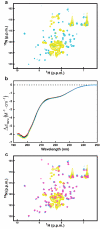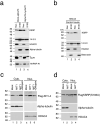Phosphorylation-mediated unfolding of a KH domain regulates KSRP localization via 14-3-3 binding
- PMID: 19198587
- PMCID: PMC2858377
- DOI: 10.1038/nsmb.1558
Phosphorylation-mediated unfolding of a KH domain regulates KSRP localization via 14-3-3 binding
Abstract
The AU-rich element (ARE)-mediated mRNA-degradation activity of the RNA binding K-homology splicing regulator protein (KSRP) is regulated by phosphorylation of a serine within its N-terminal KH domain (KH1). In the cell, phosphorylation promotes the interaction of KSRP and 14-3-3zeta protein and impairs the ability of KSRP to promote the degradation of its RNA targets. Here we examine the molecular details of this mechanism. We report that phosphorylation leads to the unfolding of the structurally atypical and unstable KH1, creating a site for 14-3-3zeta binding. Using this site, 14-3-3zeta discriminates between phosphorylated and unphosphorylated KH1, driving the nuclear localization of KSRP. 14-3-3zeta -KH1 interaction regulates the mRNA-decay activity of KSRP by sequestering the protein in a separate functional pool. This study demonstrates how an mRNA-degradation pathway is connected to extracellular signaling networks through the reversible unfolding of a protein domain.
Figures







Similar articles
-
The structure of the C-terminal KH domains of KSRP reveals a noncanonical motif important for mRNA degradation.Structure. 2007 Apr;15(4):485-98. doi: 10.1016/j.str.2007.03.006. Structure. 2007. PMID: 17437720
-
Orientation of the central domains of KSRP and its implications for the interaction with the RNA targets.Nucleic Acids Res. 2010 Aug;38(15):5193-205. doi: 10.1093/nar/gkq216. Epub 2010 Apr 12. Nucleic Acids Res. 2010. PMID: 20385598 Free PMC article.
-
KH-type splicing regulatory protein interacts with survival motor neuron protein and is misregulated in spinal muscular atrophy.Hum Mol Genet. 2008 Feb 15;17(4):506-24. doi: 10.1093/hmg/ddm327. Epub 2007 Nov 12. Hum Mol Genet. 2008. PMID: 17998247
-
The Role of KH-Type Splicing Regulatory Protein (KSRP) for Immune Functions and Tumorigenesis.Cells. 2022 Apr 28;11(9):1482. doi: 10.3390/cells11091482. Cells. 2022. PMID: 35563788 Free PMC article. Review.
-
The role of KSRP in mRNA decay and microRNA precursor maturation.Wiley Interdiscip Rev RNA. 2010 Sep-Oct;1(2):230-9. doi: 10.1002/wrna.2. Epub 2010 May 6. Wiley Interdiscip Rev RNA. 2010. PMID: 21935887 Review.
Cited by
-
RNA-binding protein KHSRP promotes tumor growth and metastasis in non-small cell lung cancer.J Exp Clin Cancer Res. 2019 Nov 27;38(1):478. doi: 10.1186/s13046-019-1479-2. J Exp Clin Cancer Res. 2019. PMID: 31775888 Free PMC article.
-
The interplay between transcription and mRNA degradation in Saccharomyces cerevisiae.Microb Cell. 2017 Jul 3;4(7):212-228. doi: 10.15698/mic2017.07.580. Microb Cell. 2017. PMID: 28706937 Free PMC article. Review.
-
Balancing LncRNA H19 and miR-675 Bioconversion as a Key Regulator of Embryonic Myogenesis Under Maternal Obesity.J Cachexia Sarcopenia Muscle. 2025 Apr;16(2):e13791. doi: 10.1002/jcsm.13791. J Cachexia Sarcopenia Muscle. 2025. PMID: 40162559 Free PMC article.
-
Emerging Evidence of Translational Control by AU-Rich Element-Binding Proteins.Front Genet. 2019 May 2;10:332. doi: 10.3389/fgene.2019.00332. eCollection 2019. Front Genet. 2019. PMID: 31118942 Free PMC article. Review.
-
KH domains with impaired nucleic acid binding as a tool for functional analysis.Nucleic Acids Res. 2012 Aug;40(14):6873-86. doi: 10.1093/nar/gks368. Epub 2012 Apr 29. Nucleic Acids Res. 2012. PMID: 22547390 Free PMC article.
References
-
- Audic Y, Hartley RS. Post-transcriptional regulation in cancer. Biol. Cell. 2004;96:479–498. - PubMed
-
- Kontoyannis D, Pasparakis M, Pizarro TT, Cominelli F, Kollias G. Impaired on/off regulation of TNF biosynthesis in mice lacking TNF AU-rich elements: implications for joint and gut-associated immunopathologies. Immunity. 1999;10:387–398. - PubMed
-
- Chen C-Y, et al. AU binding proteins recruit the exosome to degrade ARE-containing mRNAs. Cell. 2001;107:451–464. - PubMed
Publication types
MeSH terms
Substances
Associated data
- Actions

